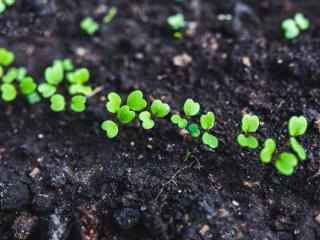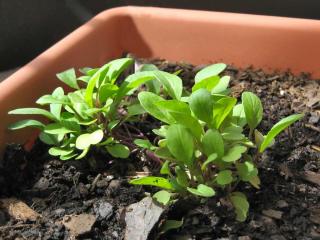

Arugula is one of the most famous greens for tasty meals.
Key Arugula facts
Name – Eruca sativa
Family – Brassicaceae
Type – annual
Height – 8 to 10 inches (20 to 25 cm)
Soil – ordinary
Exposure: full sun, part sun, shade – Harvest: 2 months after sowing
Care, from growing to harvesting, is easy and the result is deliciously savory.
Arugula can be sown twice in the year, from April to August for a harvest from June to November and in September-October for a harvest in spring.
 Direct sowing is the method to use for sowing from April until the end of summer.
Direct sowing is the method to use for sowing from April until the end of summer.
Smart gardeners stage the sowing to extend the harvest as long as possible. Certain varieties resist cold weather well.
 When the plants have grown a couple leaves, thin and remove the weakest plants. Normally you’d only keep one sprout every 2 to 4 inches (5 to 10 cm). Sprouting usually occurs about ten days after sowing, and thinning can be done immediately when first true leaves appear.
When the plants have grown a couple leaves, thin and remove the weakest plants. Normally you’d only keep one sprout every 2 to 4 inches (5 to 10 cm). Sprouting usually occurs about ten days after sowing, and thinning can be done immediately when first true leaves appear.
Good to know: sprinkle the seedlings you’ve pulled out on tossed salads or as a side. They’re very nutritious micro-greens!
 Growing arugula in a pot is perfectly possible. Simply make sure of the following:
Growing arugula in a pot is perfectly possible. Simply make sure of the following:
The epitome of the easy plant to care for, arugula doesn’t require any care other than watering regularly if it doesn’t rain.
 Lack of water will indeed trigger bolting, which makes the leaves more spicy or bitter.
Lack of water will indeed trigger bolting, which makes the leaves more spicy or bitter.
As for pests, you might come across large white, which is a butterfly that lays eggs on most types of cabbage and soft-leaved plants.
You can collect your first leaves about 6 weeks after sowing, in spring or in fall.
 Break off leaves according to your needs, snipping them off at the collar.
Break off leaves according to your needs, snipping them off at the collar.
Note that arugula can be sown quite late. If fall is very mild and if you’ve got cold frames in place, you can actually harvest it all winter long.
Producers have nifty harvesting devices that make it much faster to harvest larger quantities.
 Growing arugula is very easy because it adapts to almost any type of soil and exposures.
Growing arugula is very easy because it adapts to almost any type of soil and exposures.
Arugula is part of the same family as other famous vegetables like cabbage and broccoli.
Reputed for its spicy taste, arugula also has a high nutritious value.
 Arugula is often paired to lettuce to spice it up a bit, or is simply eaten raw together with a fresh tomato, cherry tomatoes and sliced cucumber and bell pepper which will soften its taste a bit.
Arugula is often paired to lettuce to spice it up a bit, or is simply eaten raw together with a fresh tomato, cherry tomatoes and sliced cucumber and bell pepper which will soften its taste a bit.
Lastly, note that arugula has high antioxidant powers, and thus protects your body from ageing and from certain diseases such as cancer.
When harvesting, don’t pull out the entire plant, simply snip off as many leaves as you need. The plant will keep growing and will send out new shoots, which you can then harvest again and again for a long time.
Oh my gosh I’ve been throwing the seedlings I thin out every time till now! Lesson learned, now I’ll get a few more greens out from my balcony, lucky me